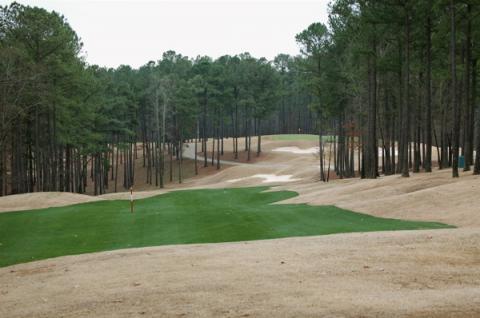
The Oxmoor Valley course on the Robert Trent Jones Trail is one of the few with some housing within view of the course. Above is the unique par 4 12th hole with a double fairway separated by a large grove of trees (to the right here). The left fairway is tougher to hit off the tee, but the easier approach to the protected green.
As the flagsticks go into the cups north of the Mason-Dixon line, golfers in the southern U.S. are already warmed up for the season. Most golf courses in the Carolinas on down have been open all winter except for a few frigid and snowy days. Southern golfers' idea of the new playing season is for the dormant grasses in the rough to go from brown to green. That is starting to happen everywhere.
This is also the season, especially in this economy, when affiliated golf courses offer their discount cards or "passports," which offer low-priced green fees and discounts on merchandise and, in some cases, restaurant meals. No discount program I know of is a better deal than the Robert Trent Jones Trail Card because no affiliated group of courses is consistently better, in my experience.
The card costs a mere $39 annually for residents of Alabama or anyone who lives within 100 miles of a Jones Trail course. By my calculation, that brings some border towns in Georgia and Tennessee into play.
Lucky them. With the Card, discounts range from just $34.95 at Silver Lakes near Anniston (played it, liked it) to $39.95 at Grand National in Opelika (liked it) to $44.95 at Oxmoor Valley in Birmingham (loved it) to the $79.95 at the tournament tested Ross Bridge, also in Birmingham (didn't play). Rates include a golf cart which, at many high-end public courses, can run as high as $30 alone. During the summer, rates for those without the Card run from $62 to $136 for the same courses.
There are very few homes adjacent to the Jones Trail courses, but here are a few listings I found. Of course, there is a wide selection of homes within a mile or two of almost all 26 courses on the trail:
Grand National Golf Club, Opelika, AL
5 BR, 4 ½ BA two-year old home with 3-car garage and deck overlooking course
$545,900
Oxmoor Valley Golf Club, Birmingham, AL
The Cornerstones, 2 & 3 BR condominiums, 1,700 square feet and up, overlooking 17th fairway
Prices begin at $220,000
Lakewood Golf Club, Point Clear, AL
The Commons condominiums, 2 & 3 BR condos, 1,350 square feet and up, near Mobile Bay.
Prices begin at $425,000
























